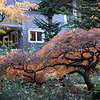Travel can expose you to once-in-a-lifetime sights and experiences, and a good camera can be the perfect way to preserve those memories. We've looked at a range of models that offer great image quality, good autofocus and excellent video, so that you can capture whatever you encounter on your travels. We've also tried to select relatively small cameras so they don't interfere with your trip.
Our selections include relatively compact cameras with fixed lenses, perfect for just documenting what you saw on your trip; they also include Micro Four Thirds and APS-C models that allow smaller camera/lens combinations, if you're looking to travel light. Full-frame cameras open up the potential for even better image quality but the lenses can get pretty big, so it's worth checking how big the total package is, before committing to a large-sensor model.
Our recommendations
- Best pocketable travel camera: Ricoh GR III
- The classic choice: Fujifilm X100V
- Truly compact mirrorless: OM System OM-5
- All-round compact capability: Sony a6700
- The great travel kit: Fujifilm X-S20 with 18-55mm F2.8-4.0 OIS
- The stylish travel companion: Nikon Zf
- Portable full-frame: Sony a7CR
Best pocketable travel camera: Ricoh GR III
24MP APS-C sensor | 28mm equiv. F2.8 lens | Wi-Fi + Bluetooth
 |
|
The Ricoh is a pocketable compact with a large APS-C sensor. Photo: Barney Britton |
Buy now:
What we like:
- Excellent image quality
- Good controls and ergonomics
- Truly pocketable
What we don't:
- Short battery life
- No built-in flash
- Sluggish AF in low light
The Ricoh GR III is the latest in a series of classic compact cameras with a large APS-C sensor and an 28mm equivalent lens. It's not the most flexible camera but it's one of the most pocketable and has built up a dedicated following of photographers who find it a joy to shoot with.
Our only concern, in terms of using the GR III for travel are that some users have found dust can get into the lens. So it's worth trying to find some sort of protective bag to keep it in.
There's also the GR IIIx, a variant with a longer, 40mm equivalent lens on it. This may be a little tight for documenting your travels, but it's historically a popular focal length.
See the Ricoh GR III studio scene
The classic choice: Fujifilm X100V
26MP APS-C X-Trans sensor | 35mm equiv. F2 lens | Hybrid viewfinder
 |
|
The Fujifilm X100V makes an excellent travel companion, if you can find one. Photo: Dan Bracaglia |
Buy now:
What we like:
- Fujifilm's latest sensor is excellent
- Tilting, touch-enabled screen
- Remarkably strong video features
- Excellent build quality
What we don't:
- Lens's AF speed on the slow side
- No stabilization of any kind
- Arguably too many dials
The Fujifilm X100V is a classically styled fixed lens camera with a 26MP APS-C camera sited behind a 35mm equivalent F2 lens.
The X100V isn't the smallest or most inconspicuous camera, but its fixed focal length means you develop an 'eye' for the photos it'll take, essentially making it a better quality, more engaging alternative to snapping away with your phone.
It's worth noting that, despite being one of our picks, supplies have been limited for a while: we wouldn't recommend paying significantly over the $1399 list price.
Read our Fujifilm X100V review
See the Fujifilm X100V studio scene
Truly compact mirrorless: OM System OM-5
20MP Four Thirds CMOS sensor | 4K/30p video | In-body stabilization rated to 6.5EV (7.5 with some lenses)
 |
| Photo: Brendan Nystedt |
Buy now:
What we like:
- Attractive JPEG output
- Selection of clever photo features
- Excellent image stabilization
- IP53 rating supports claims of weather sealing
What we don't:
- AF tracking is disappointing
- Image quality is behind larger sensor cameras
The OM System OM-5 is a compact interchangeable lens camera with a 20MP Four Thirds sensor in a compact body with plenty of external control.
That relatively small sensor means it can remain fairly small, even with a lens attached, and the Micro Four Thirds lens system provides extensive options in that regard, from compact zooms to small prime lenses.
Read our OM System OM-5 review
See the OM System OM-5 studio scene
All-round compact capability: Sony a6700
26MP BSI CMOS sensor | 4K/60p video capture | Fully articulating screen
 |
| Photo: Richard Butler |
Buy now:
What we like:
- Front and rear command dials
- Excellent AF in stills and video
- 4K/120p capture (with crop)
What we don't:
- No AF joystick
- JPEG sharpening can be aggressive
The Sony a6700 is built around a 26MP APS-C-sized sensor. Its excellent autofocus performance means it excels at both stills and video capture. There's a good choice of relatively compact lenses available, too. We'd suggest avoiding the really small 16-50mm F3.5-5.6 though: it's not the lens to get the most out of this camera.
Fast, dependable autofocus with a selection of subject recognition modes means the a6700 will help maximize your chances of capturing the unexpected moments on a trip.
Read our full Sony a6700 review
See the Sony a6700 studio scene
The great travel kit: Fujifilm X-S20 with 18-55mm F2.8-4.0 OIS
26MP X-Trans APS-C sensor | Up to 6.2K/30P 10-bit video | In-body image stablization
 |
| Photo: Shaminder Dulai |
Buy now:
What we like:
- Excellent still and video quality
- Long battery life
- Comfortable, simple ergonomics
What we don't:
- AF tracking still lags behind peers
- Small electronic viewfinder
- Micro HDMI instead of full-size
Fujifilm's X-S20 is also worth considering. Like the a6700, it's built around a 26MP BSI CMOS sensor and is strong at both stills and video. Its autofocus isn't as simple and powerful as the Sony's, but its JPEG color modes produce really attractive results, and there's a wide choice of lenses including compact prime and the well-priced, supremely useful 18-55mm F2.8-4.0 OIS, which is a great travel option.
Read our Fujifilm X-S20 initial review
See the Fujifilm X-S20 studio scene
The stylish travel companion: Nikon Zf
24MP full-frame BSI CMOS sensor | Full-width 4K/30 video, cropped 4K/60 | Stabilization rated to 8EV
 |
| Photo: Richard Butler |
Buy now:
What we like:
- Distinctive design with direct controls
- Effective subject recognition
- Strong stills and video features
What we don't:
- Weight and minimal grip can become uncomfortable
- Slow MicroSD second slot
- Few custom buttons
The Nikon Zf is a classically styled full-frame camera built around a 24MP full-frame sensor that's used by many of its peers. The angular 80s-style body isn't the most comfortable to hold in your hand for extended periods, but the lack of stick-out grip makes it smaller than many of its rivals, making it a tempting travel companion.
At least in its all-black form, there's a chance of it being mistaken for a film camera, which may help avoid the wrong kind of attention, when you're out and about in an unfamiliar setting.
Read our initial review of the Nikon Zf
Portable full-frame: Sony a7CR
61MP BSI CMOS sensor | 4K/60p video with 10-bit color | Dedicated ‘AI’ processor for AF system
 |
| Photo: Richard Butler |
Buy now:
What we like:
- Big camera features in a small body
- Outstanding AF performance
- Auto Framing video mode
What we don't:
- Small, low-res viewfinder
- No joystick control
- No fully mechanical shutter
The Sony a7CR is a relatively compact full-frame camera with an image-stabilized 61MP CMOS sensor. You sacrifice the convenience of an AF joystick and get a pretty small and basic viewfinder to keep the camera's size down, but there's little else that delivers this much image quality in such a compact package.
You'll need to pick your lenses carefully to keep the camera portable but the a7CR's autofocus means it can respond rapidly to just about anything you encounter on your travels.
Read our Sony a7CR initial review
Why you should trust us
This buying guide is based on cameras used and tested by DPReview's editorial team. We don't select a camera until we've used it enough to be confident in recommending it, usually after our extensive review process. The selections are purely a reflection of which cameras we believe to be best: there are no financial incentives for us to select one model or brand over another.










































































